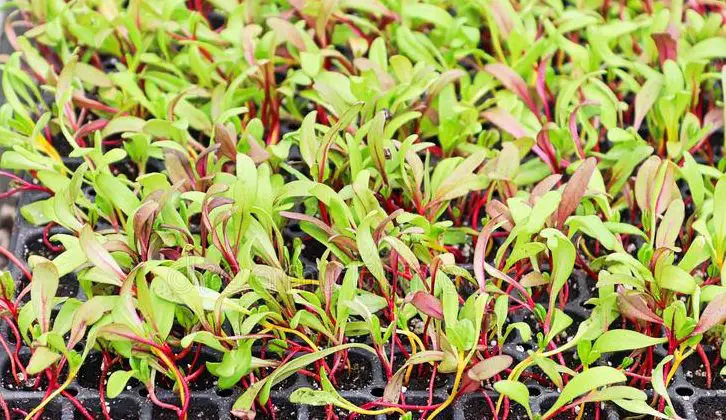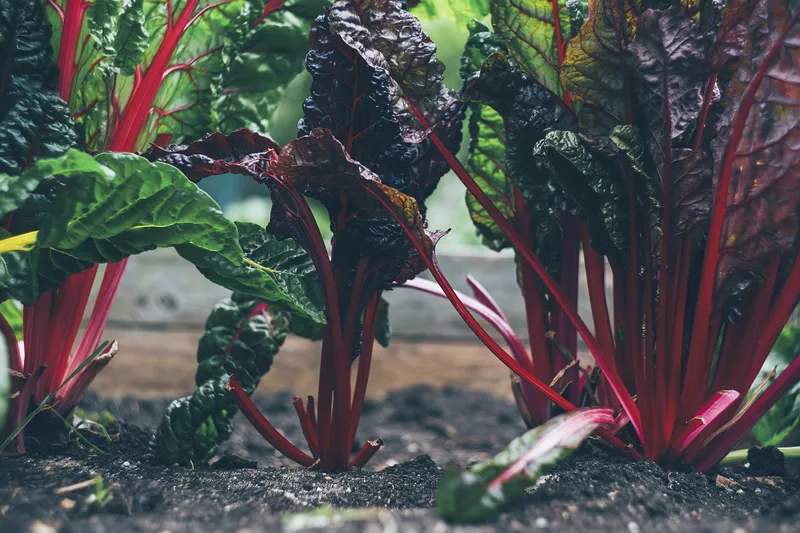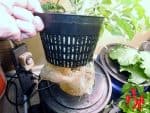This post contains affiliate links. If you buy something from one of our links we may earn a commission. Thanks

To grow Swiss Chard microgreens, start by gathering supplies like seed trays, potting soil, and Swiss chard seeds. Prepare your trays with soil, sow the seeds evenly, and lightly water them.
Place the trays in a sunny spot or under a grow light, ensuring they receive at least 6 hours of light daily. Monitor their moisture levels, avoiding over-watering.
Within 3-7 days, sprouts will emerge. Once they reach about 3-4 inches in height, they are ready for harvesting. Enjoy your Swiss Chard microgreens fresh from your indoor garden!

Growing microgreens is a simple and rewarding way to add fresh and healthy greens to your diet.
We will show you how to grow Swiss chard microgreens in 7 easy steps.
If you’re new to growing microgreens, Swiss chard is a great place to start.
It grows quickly and easily, making it a great choice for beginner gardeners or those who don’t have much time on their hands.
So if you’re ready to get started, here are seven easy steps for growing Swiss chard microgreens in your own home. But first:
What Is Swiss Chard?

Swiss chard (Beta vulgaris subsp. vulgaris Flavescens group) is a leafy green vegetable that belongs to the beet family.
It is closely related to beets, spinach, and quinoa and is native to the Mediterranean region.
 Swiss chard is known for its large, dark green leaves and thick, crunchy stems, which can be either white, yellow, red, or rainbow colored.
Swiss chard is known for its large, dark green leaves and thick, crunchy stems, which can be either white, yellow, red, or rainbow colored.
Get rainbow chard seeds on Amazon.
It is a highly nutritious vegetable that is rich in vitamins, minerals, and high levels of antioxidants and is a good source of fiber, protein, and iron.
Swiss chard is often used in a variety of dishes, including salads, stir-fries, soups, and side dishes.
It can also be eaten raw or cooked and has a slightly bitter, earthy flavor.
Chard, like other green leafy vegetables, has highly nutritious leaves, making it a popular component of healthy diets. Chard has been used in cooking for centuries, but because it is the same species as beetroot, the common names that cooks and cultures have used for chard may be confusing; it has many common names, such as silver beet, perpetual spinach, beet spinach, seakale beet, or leaf beet. https://en.wikipedia.org/wiki/Chard
How To Grow Swiss Chard Microgreens In 7 Easy Steps
Step 1: Gather Your Supplies
 The first step is always the most fun—shopping. You’ll need some basic supplies for growing microgreens, such as seed trays or planting containers, potting soil, seeds, and water.
The first step is always the most fun—shopping. You’ll need some basic supplies for growing microgreens, such as seed trays or planting containers, potting soil, seeds, and water.
A spray bottle can also be helpful for gently misting your seedlings. If you don’t have any of these items on hand already, you can find them at many garden supply stores or online retailers.
Here is a link to Ruby Red Swiss Chard seeds or you can get Rainbow Swiss Chard seeds on Amazon.
If you don’t have direct sunlight or enough natural light consider using a supplemental lighting source.
Step 2: Prepare Your Trays
 Once you’ve gathered all your supplies, it’s time to prepare your trays for planting.
Once you’ve gathered all your supplies, it’s time to prepare your trays for planting.
You can reuse a shallow plastic container like a recycled food container as long as it is clean but I recommend using these 1020 seed trays from Bootstrap Farmer for a microgreens tray.
These microgreen trays are heavy-duty and can be reused for many years.
Bottom Watering
I like to sow seeds and then bottom water them. This keeps seeds from being uncovered or washed out of place. To do this you need two trays.
One tray should have drainage holes and hold your growing medium. The other tray has no holes and holds some water.
To bottom water place the tray with your soil into the water in the bottom tray.
Once you have moist soil you will be ready for planting. You probably only need to do this once. From then on mist your seeds.
Start by filling each shallow tray with enough potting soil until it reaches about one-half inch from the top.
Make sure the soil is light and nicely moistened before adding the seeds. This will ensure that they germinate properly.
Coco coir is the best growing medium for starting seeds. You can also use potting soil or a seed starter mix.
Step 3: Plant Your Seeds
 Now it’s time to start planting. Make sure your microgreen seeds are organic and non-GMO.
Now it’s time to start planting. Make sure your microgreen seeds are organic and non-GMO.
Swiss chard seeds are a lot like beet seeds and there are several seeds in each bark-like seed husk.
This can affect the number of plants you have and your seed density when planting.
You can soak your seeds overnight for faster germination but they are a bit harder to plant when wet.
Sprinkle the Swiss chard seeds evenly across the soil surface of your growing tray and press them gently into the soil with your fingers.
You can cover them with a thin layer of soil if you prefer.
You want to have a full tray of microgreens but still make sure there’s enough room between each seed so that they have space to grow without overcrowding each other when they sprout up later on.
By the way, you can get similar results with beetroot microgreens using beet seeds.
Step 4: Water Your Seeds
Once all your seeds are planted in the trays, give them a good watering with your spray bottle or watering can. Don’t water with cold water it should be at room temperature.
Be careful not to overwater; too much moisture can cause mold or mildew growth which will prevent your Swiss chard microgreens from germinating properly.
Overwatering is one of the most common mistakes beginners make.
Instead of dousing them directly with water, lightly mist them until they’re damp but not soaked through.
Some people recommend using a blackout dome which will promote longer red stems. This is not needed and I recommend skipping this blackout period.
It’s good for commercial microgreen growers who are paid by the pound. But as a home grower, I prefer more leaves and less stems because they have more nutrition than the stems.
Step 5: Place in Sunlight
Now that your trays are watered and planted with Swiss chard seeds, it’s time to find them a sunny spot like a sunny windowsill.
Direct sunlight is fine as long as your tray doesn’t get too hot. Place them in an area that gets plenty of indirect sunlight if that’s the case.
They do need bright light throughout the day for at least 6 hours.
This will help ensure that they get enough light. If you can’t supply this consider adding a grow light like the one below.

Step 6: Monitor Progress
Check on your trays every couple of days and make sure they’re receiving enough water without becoming soggy or moldy.
Don’t keep them in areas where there isn’t much air circulation but avoid drafty areas too.
After about 3-7 days you should start seeing some sprouts coming up.
At this point, you can move them into an area with more direct sunlight if needed in order to encourage further growth.
Step 7: Harvest & Enjoy
Once your Swiss chard microgreens reach about 3-4 inches tall (or whatever size you prefer), they’re ready for harvesting.
Cut them off using scissors or a sharp knife just above soil level and enjoy them as part of salads, sandwiches, and soups—the possibilities are endless.
You can also thin out your microgreens as they grow and save some plants for their leafy greens. Don’t cut them at the soil line. Instead, remove individual leaves.
How To Store Swiss Chard Microgreens
You can store your microgreens in the refrigerator for about a week in a plastic bag or container with holes in it.
Swiss chard leaves can be frozen for several months too but their color and texture will change.
Swiss Chard Microgreens Taste
Swiss chard, also known as silverbeet or spinach beet, is a leafy green vegetable that is often used in cooking.
It has a slightly bitter, earthy taste that is similar to spinach, with a slightly sweet, metallic flavor that comes from the mineral-rich veins running through the leaves.
Swiss chard can be enjoyed cooked or raw, and is often used in dishes like salads, soups, stews, and stir-fries. It can also be sautéed, braised, or baked into dishes like frittatas, quiches, and casseroles.
Swiss chard is a good source of vitamins, minerals, and antioxidants, and is a versatile ingredient that can be used in a variety of dishes.
Swiss chard microgreens have a slightly bitter, earthy taste that is similar to mature Swiss chard leaves.
They are often used as a garnish or added to salads, sandwiches, and other dishes for a burst of flavor and nutrition.
Some people also enjoy them as a snack, either raw or lightly cooked.
Swiss Chard Microgreens Benefits
Disclaimer: I am not a physician and don’t play one on TV either. The material on this site is not a substitute for professional medical advice, diagnosis, or treatment. Always seek a physician’s advice before using any information you find on this website to treat or prevent any condition.
Swiss chard microgreens are a type of young, tender vegetable that is harvested shortly after the cotyledon leaves (the first leaves to appear after germination) have developed.
They are a rich source of nutrients, including vitamins, minerals, and antioxidants, and have been shown to have a number of potential health benefits.
Some of the potential benefits of Swiss chard microgreens include:
Nutrient-rich: Swiss chard microgreens are a good source of vitamins A, C, and K, as well as minerals like iron, calcium, and potassium. They are also a good source of antioxidants, which can help to protect against cellular damage and inflammation.
Heart health: Swiss chard microgreens are rich in fiber, which can help to lower cholesterol levels and reduce the risk of heart disease. They are also a good source of antioxidants, which can help to reduce inflammation in the body and protect against heart disease.
Eye health: Swiss chard microgreens are a good source of lutein and zeaxanthin, two antioxidants that are important for eye health. These nutrients can help to protect against age-related macular degeneration and cataracts.
Bone health: Swiss chard microgreens are a good source of calcium, which is important for maintaining strong bones and teeth. They are also a good source of vitamin K, which plays a role in bone metabolism and can help to reduce the risk of osteoporosis.
Digestive health: Swiss chard microgreens are a good source of fiber, which can help to improve digestion and prevent constipation. They are also a good source of antioxidants, which can help to reduce inflammation in the digestive system and protect against conditions like inflammatory bowel disease.
It’s important to note that more research is needed to fully understand the potential health benefits of Swiss chard microgreens. As with any food, it’s important to consume them as part of a balanced diet.
Many studies have suggested that consuming more plant foods such as Swiss chard decreases the risk of obesity, diabetes, heart disease and overall mortality and promotes a healthy complexion, increased energy, and overall lower weight. https://www.medicalnewstoday.com/articles/284103
Swiss Chard Microgreens Nutrition
Swiss chard microgreens are a type of young, tender vegetable that is harvested shortly after the cotyledon leaves (the first leaves to appear after germination) have developed.
They are a rich source of nutrients, including vitamins, minerals, and antioxidants, and can be a healthy addition to your diet.
Just 1 cup (175 grams) of cooked Swiss chard contains
• Calories: 35
• Protein: 3.3 grams
• Carbs: 7 grams
• Fiber: 3.7 grams
• Vitamin K: 477% of the Daily Value (DV)
• Vitamin A: 60% of the DV
• Magnesium: 36% of the DV
• Vitamin C: 35% of the DV
• Copper: 32% of the DV
• Manganese: 25% of the DV
• Iron: 22% of the DV
• Vitamin E: 22% of the DV
• Potassium: 20% of the DV
• Calcium: 8% of the DV
https://www.healthline.com/nutrition/swiss-chard
Swiss chard microgreens are also a good source of antioxidants, including lutein and zeaxanthin, which are important for eye health, and beta-carotene, which can help to boost the immune system.
The nutrient content of Swiss chard microgreens may vary depending on the variety of Swiss chard and growing conditions.
It is always a good idea to consult a nutritionist for more information. As with any food, it’s important to consume Swiss chard microgreens as part of a balanced diet.
Growing Swiss Chard FAQs
Growing Swiss Chard microgreens at home is an exciting venture into the world of home-grown greens. The journey from seeding to harvesting is relatively straightforward, but like any gardening endeavor, it may raise a few questions, especially for beginners.
Below are some frequently asked questions that aim to provide clarity on growing Swiss Chard microgreens. Through these Q and A, you’ll gain a better understanding and be well on your way to enjoying your own fresh, nutritious greens.
Can you grow Swiss chard microgreens?
Yes, you can grow Swiss Chard microgreens at home by following the 7 simple steps for growing Swiss chard microgreens for beginners found in this article.
Do microgreens grow back after cutting?
Most microgreens don’t grow back after cutting. A few will grow back. Pea microgreens will grow back.
Swiss chard can grow back if it is larger(baby greens) and has some true leaves, then when you harvest leave the crown and just harvest the leaves and it will continue to grow.
How long does it take to grow Swiss chard?
It will take about 3-4 days for germination and another 7-10 days to harvest at the cotyledon stage.
Q. What are the nutritional benefits of Swiss Chard microgreens?
A. Swiss Chard microgreens are nutrient-rich, providing vitamins A, C, and K, minerals like iron, calcium, and potassium, and antioxidants. They are beneficial for heart health, eye health, bone health, and digestive health, contributing to a balanced and nutritious diet.
Final Thoughts
With just seven easy steps, anyone can grow their own delicious Swiss chard microgreens right at home.
All it takes is some basic supplies like seed trays and potting soil plus a little bit of patience while waiting for those delicious greens to sprout up and be ready for harvest.
Whether you’re looking to add fresh nutrition to daily meals or just want something fun and rewarding to do in your free time outside of work or school growing microgreens may be just what you need.
Learn more: 5 Reasons To Start Growing Microgreens At Home






